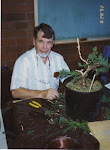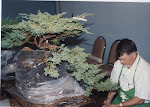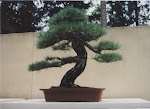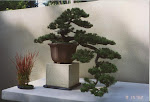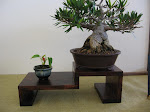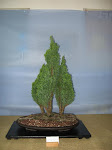Our last club meeting was so overwhelming in the things we needed to get done, that a few things were overlooked. I usually am a shutterbug and will take pictures of interesting plants during my routine work. I certainly would have taken pictures of the great items that were auctioned off. Another member is even more religious about this. Sad to say, neither of us took any pictures.
I therefore tracked down one of our new members, Sandy of Port Angeles and asked her to forward a picture of the Phoenix style Juniper that she had bought. She has promised to do so, and when uploaded it will be featured on our home page.
There is another photo that I really wanted. It was one of my own plants, a Black Pine. This certainly was not a centerfold attraction by any means … but it leads to what I intend to do with an article.
I would like a Before and After photograph of trees that you are going to re-shape and re-pot. This Pine would have been a good beginning, as it will need some root pruning and a first time bonsai pot – or a training pot. You see it still has years to go. More on that tree later.
Recently l did some major revision on two maple trees and did not take the before picture, so those opportunities are lost. I am however thinking of doing the same to an Acer griseum (Paperback Maple) that simply is not doing it for me. The change will be drastic and it will also be getting a new pot.
Though some twenty years old, this child has not pleased me. Poor training for sure. Poor choice of pot. The top view is even more terrible. This guy is in for a major makeover, and despite Jerry's nice comments that Maples are feminine, this one is not. I intend to take out more than half of the branches, leaving only three. The choice is not clear yet, but it will be done. One potential look being shown below. Best I could do with Photoshop
Edit, much is said about front and back. I think a top view can also show equal errors in style. Sorta like a bald man seen from the front or the back, but when seen from the top. WOW-- It Shows big time!
Returning to three major branches will also alow me to de-pot and re-plant in better draining soil. The pot needs to be replaced with a Japanese rectangular sized pot, either earth tone or red to match the beauty of this bark. Acer griseum is a strangely underused bonsai maple. I have never understood why. It is tough, slow growing and has great fall color and magnificent seed pods. What more could one want?
Mind you, this pruning has only been done by PHOTOSHOP. I will await a second opinion and that is what the club is all about. I will probably do this in a few months. Wiring of lower limbs will be needed.

I have already re-potted it into a more flattering container, but will not prune it until spring. I will however air-layer all the limbs that will be deleted.
I am equally interested that Chris bought a Trident Maple that I had bid on. It needed much work, but will prove to be a great tree. Will Chris turn a 100-dollar tree into a 200-dollar tree? We will see. I hope to catch him before he starts working on it. A silhouette picture of before and after would be very instructive.
I therefore ask all of you who are planning major revisions of your plants, to take a photo of them before the action. Explain your problem or complaint and then take a picture of the finished job. I will then left and right justify those pictures with commentary beneath.
Back to the Pine. That was a bargain! It had been worked on for years, and then put into the ground for three years to gain girth. It was neglected, not pruned and had become a beast. This Spring I dug it out, root pruned it and took out some 50 percent of the limbs. I would not do much further pruning of limbs until next year. Re-potting is a must. Needlework and tip pinching are needed. Next year, more limbs can be removed and I suspect that in two years the new owner will have an exceptional plant. I thank the person, who saw the swan in the ugly duckling.
Please upload your pictures to
bonsaiherb@gmail.com
Herb S.


